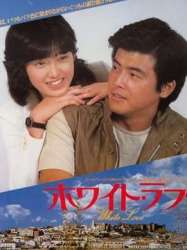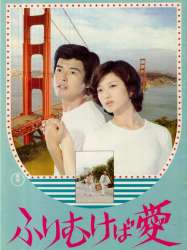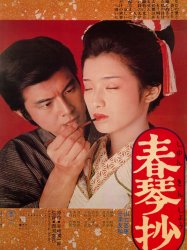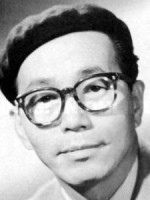Momoe Yamaguchi est une Actrice Japonaise née le 17 janvier 1959 à Shibuya (Japon)

Momoe Yamaguchi (Japanese: 山口 百恵, Hepburn: Yamaguchi Momoe, born 17 January 1959) is a Japanese former singer, actress, and idol whose career lasted from 1972 to 1980. Often simply referred to by her given name, "Momoe", Yamaguchi was one of the most successful singers in Japanese music in her day, releasing 32 singles, including three number one hits, and 21 albums. She also starred in 15 feature films and several serial dramas on television. At 21, Yamaguchi retired at the height of her popularity to marry her frequent costar, Tomokazu Miura; she has never performed or made a public appearance since.
Momoe Yamaguchi was born in Tokyo, Japan in 1959. Not long afterwards she was left in the care of her maternal grandparents. At around four, she was returned to her parents and the family then moved to Yokohama. Her father, who was already married to another women with children, and never married to her mother. The family moved once again to Yokosuka. Her mother raised Momoe and her younger sister Toshie by herself.
Yamaguchi began a career in show business while she was still a student in junior high school. At the end of 1972, at the age of 13, Yamaguchi, along with many of her schoolmates, applied by postcard to appear on the idol talent search television show Star Tanjō!. After a series of successful preliminary auditions, she appeared on the show covering a hit song "Kaiten Mokuba", by Yumi Makiba earlier that year. Though she finished second, Yamaguchi received offers from several music producers, and signed with Hori Productions. Her family moved to Tokyo. Yamaguchi transferred to Shinagawa Joshi Gakuin, and then attended Hinode Joshi Gakuin High School, a school which allows its students to carry on careers in show business.
Initially she was promoted together with two other singers, Junko Sakurada and Masako Mori, as the Hana no Chūsan Torio (meaning "The lovely trio of third-year middle school students") since they were all in the third year of middle school (chūsan).
Her first single, "Toshigoro", coupled with her first movie of the same title, did not fare well in the charts, peaking at 37 on the Oricon singles chart. But her second single "Aoi Kajitsu" peaked at number 9. Japanese pop culture historians have credited its success to its suggestive lyrics. The chorus goes "You can do what ever you want with me; it's OK if rumors spread that I'm a bad girl".
Her early songs, including the ones with suggestive lyrics, were written for her by the Hori Productions songwriting team of composer Shunichi Tokura and lyricist Kazuya Senge. One of her biggest hits was her 5th single "Hito natsu no Keiken" ("an experience one summer"), which includes lyrics like "I'll give you the most precious thing a girl has". and "Everyone experiences it at least once, the sweet trap of seduction". The suggestive lyrics attracted widespread press interest. The young singer was frequently asked salacious questions such as "What do you think a girl's most precious thing is?", to which she replied magokoro ("her devotion").
Rising popularity
By the end of 1974, her phenomenal popularity was demonstrated by her being invited to be the opening female singer for the 25th Kōhaku Uta Gassen, Japan's most popular musical show, with the song Hito Natsu No Keiken. She would continue to appear in this show every year until her retirement.
But what really launched Momoe to stardom and signaled the second stage of her career were the songs written for her by husband-wife team of lyricist Yoko Agi and composer Ryudo Usaki. These so-called "punk" (tsuppari) songs, including "Yokosuka Story" and "Playback Part 2," proclaimed that Momoe was no longer a girl who could be used by men, but a woman ready to stand on her own two feet and take charge of her own life. Initially Momoe's agency and record company had opposed using this pair, saying that their music didn't fit her image, but she had insisted- and changed her image instead.
Mark Schilling, An Encyclopedia of Japanese Pop Culture
With her increasing popularity, Yamaguchi gained more control over her career and was able to select her own songwriters. One of her choices was Ryudo Uzaki. She chose him because she liked his song "Secret Love", recorded by the Down Town Boogie Woogie Band. Their first collaboration resulted in the single "Yokosuka Story" in 1976, written by Uzaki with lyrics by his wife, Yoko Aki. Aki was inspired to write the song because both she and Yamaguchi, whom she had never met when the song was originally ordered, had both lived in Yokosuka. "Yokosuka Story" was Yamaguchi's biggest hit, selling more than 600,000 copies, and peaked at number one on the charts. This was the beginning of a collaboration with the husband and wife songwriting team which only ended with Yamaguchi's retirement. Songs were also written for her by writers such as Masashi Sada, who wrote one of her most popular hits, "Cosmos".
Her popularity as a singer was paralleled by rising success in a series of films and television programs. Her second film, Izu no Odoriko, paired her with actor Tomokazu Miura, chosen because he had previously done a commercial for Glico with her. Though Yamaguchi was just 14, and Miura was 22, they had great screen chemistry, and became known as the Momoe-Tomokazu "golden combi". They starred together in a total of 14 of her 17 movies, one every winter and summer.
As she became popular, her father, Kubo, decided to cash in on her success. He held bogus "press conferences" unauthorized by either Yamaguchi or her management company, and in various ways disrupted her career. Since Yamaguchi was still a minor, he sued for the right of parental authority. The court case ended in a victory for her mother. Yamaguchi declared in her autobiographical book that she ended her relationship with her father, and would never acknowledge his existence again. She also expressed the regret that if she had not become famous, this would not have happened.
By the end of her career, Yamaguchi's music became more sophisticated. Her 12th and 18th albums, Golden Flight and L.A. Blue, were recorded in London and Los Angeles respectively, using local musicians and production staff. Her 21st album, Phoenix Densetsu, was written as a rock opera. Because she wanted to make a rock song before she ended her career, Uzaki and Aki wrote "Rock 'n Roll Widow" for her, which was included on the concept album Moebius's Game.
When her television series were broadcast in China in the 1980s, she also became hugely popular as an actress there, with the Akai series of television dramas achieving viewing figures of 100% on Chinese television at the time. In China she is known as 山口百惠 (the final character is slightly different from that used in Japan), pronounced "Shan Kou Bai Hui". According to a 2000 poll by the "News Station" news magazine programme, she was the Japanese person known most widely among the Chinese.
Marriage and retirement
With the on-screen romances between Yamaguchi and Tomokazu Miura, an off-screen romance grew. During a trip to Hawaii in early 1979, Miura proposed to Yamaguchi. She accepted, and she also said that she would retire from entertainment to marry him. Yamaguchi announced their relationship at a concert in October 1979, and the announcement about their marriage date and her retirement was made in March 1980. She performed a farewell concert at the Nippon Budokan on 5 October 1980, released her last album This is my trial on 21 October 1980, and released her last single "Ichie" on 19 November 1980. She also wrote the lyrics to this song under the pen name "Kei Yokosuka", and continued to write a few songs for a while after retirement, such as Ann Lewis's La Saison from 1982.
In her autobiographical book, Aoi Toki, she said that she disliked repeatedly singing the same songs. She also stated that she wanted to stop working to devote all her time to the wellbeing of her husband. She also said in an interview at the time of retirement that she did not want to continue working as a singer or an actress.
On 15 October 1980, Yamaguchi officially retired from show business, and on 19 November 1980, the pair were married. Despite several rumors of her comeback, she has devoted herself to being a homemaker and mother to two sons. Her husband, Tomokazu Miura, continued to work as an actor, even though his career up to then had mostly consisted of playing romantic leads in her films and television series.
After retirement
In the early years after her retirement at the age of twenty, few details of her daily existence as wife of actor Tomokazu Miura were too mundane for the mags' Momoe watchers to miss. Her son's postpartum homecoming, nursery school graduation ceremony, and first day at elementary school rated cover headlines- simply because Mom happened to be in the picture.
Mark Schilling, An Encyclopedia Of Japanese Pop Culture
In 1981, she wrote a book of autobiographical essays called Aoi Toki, which sold over a million copies in its first month of publication.
Despite her retirement, she is a regular feature in weekly entertainment magazines. Her family suffered considerable difficulty in attending school events due to television crews and photographers, who sometimes used deception to gain access. Fans have frequently been found hanging around her residence, and in at least one case a fan even broke in. In 1999, her husband, Tomokazu Miura, wrote a part-autobiography Hishatai detailing the problems the couple had faced.
Her two sons, Yūtarō and Takahiro Miura, both also entered careers in entertainment. Yūtarō entered the music business under the pseudonym "Yū" in a now-defunct group called "Peaky Salt". Initially it was not known that he was Momoe and Tomokazu's son. Takahiro is an actor who has appeared in several films and television programs. Takahiro is also a qualified lifeguard because he was a swimmer and surf lifesaver from high school and university.
Yamaguchi's hobby is quilt making, and she exhibits her quilts under her married name, "Momoe Miura".
In 2011, she was selected in a poll as "The ideal mother".
New musical products continue to go on sale, such as a boxed DVD set of her appearances on television program Yoru No Hitto Sutajio ("Evening Hit Studio") in 2010. In a November 2011 television interview, Ryudo Uzaki said that she still receives a healthy income from record royalties. Her television dramas continue to be available on DVD, and from 2010 have been repeated daily on the TBS Channel cable television station.
In 2011, Tomokazu Miura wrote a book entitled "Aishō" (compatibility) explaining the secret of their happy marriage. In 2012, the couple came first for the seventh consecutive year in a poll by the Meiji Yasuda life insurance company to find "the ideal celebrity couple" as considered by married people in their 20s to 50s.
Source : Wikidata
Momoe Yamaguchi

- Infos
- Photos
- Meilleurs films
- Famille
- Personnages
- Récompenses
Biographie
Early life and careerMomoe Yamaguchi was born in Tokyo, Japan in 1959. Not long afterwards she was left in the care of her maternal grandparents. At around four, she was returned to her parents and the family then moved to Yokohama. Her father, who was already married to another women with children, and never married to her mother. The family moved once again to Yokosuka. Her mother raised Momoe and her younger sister Toshie by herself.
Yamaguchi began a career in show business while she was still a student in junior high school. At the end of 1972, at the age of 13, Yamaguchi, along with many of her schoolmates, applied by postcard to appear on the idol talent search television show Star Tanjō!. After a series of successful preliminary auditions, she appeared on the show covering a hit song "Kaiten Mokuba", by Yumi Makiba earlier that year. Though she finished second, Yamaguchi received offers from several music producers, and signed with Hori Productions. Her family moved to Tokyo. Yamaguchi transferred to Shinagawa Joshi Gakuin, and then attended Hinode Joshi Gakuin High School, a school which allows its students to carry on careers in show business.
Initially she was promoted together with two other singers, Junko Sakurada and Masako Mori, as the Hana no Chūsan Torio (meaning "The lovely trio of third-year middle school students") since they were all in the third year of middle school (chūsan).
Her first single, "Toshigoro", coupled with her first movie of the same title, did not fare well in the charts, peaking at 37 on the Oricon singles chart. But her second single "Aoi Kajitsu" peaked at number 9. Japanese pop culture historians have credited its success to its suggestive lyrics. The chorus goes "You can do what ever you want with me; it's OK if rumors spread that I'm a bad girl".
Her early songs, including the ones with suggestive lyrics, were written for her by the Hori Productions songwriting team of composer Shunichi Tokura and lyricist Kazuya Senge. One of her biggest hits was her 5th single "Hito natsu no Keiken" ("an experience one summer"), which includes lyrics like "I'll give you the most precious thing a girl has". and "Everyone experiences it at least once, the sweet trap of seduction". The suggestive lyrics attracted widespread press interest. The young singer was frequently asked salacious questions such as "What do you think a girl's most precious thing is?", to which she replied magokoro ("her devotion").
Rising popularity
By the end of 1974, her phenomenal popularity was demonstrated by her being invited to be the opening female singer for the 25th Kōhaku Uta Gassen, Japan's most popular musical show, with the song Hito Natsu No Keiken. She would continue to appear in this show every year until her retirement.
But what really launched Momoe to stardom and signaled the second stage of her career were the songs written for her by husband-wife team of lyricist Yoko Agi and composer Ryudo Usaki. These so-called "punk" (tsuppari) songs, including "Yokosuka Story" and "Playback Part 2," proclaimed that Momoe was no longer a girl who could be used by men, but a woman ready to stand on her own two feet and take charge of her own life. Initially Momoe's agency and record company had opposed using this pair, saying that their music didn't fit her image, but she had insisted- and changed her image instead.
Mark Schilling, An Encyclopedia of Japanese Pop Culture
With her increasing popularity, Yamaguchi gained more control over her career and was able to select her own songwriters. One of her choices was Ryudo Uzaki. She chose him because she liked his song "Secret Love", recorded by the Down Town Boogie Woogie Band. Their first collaboration resulted in the single "Yokosuka Story" in 1976, written by Uzaki with lyrics by his wife, Yoko Aki. Aki was inspired to write the song because both she and Yamaguchi, whom she had never met when the song was originally ordered, had both lived in Yokosuka. "Yokosuka Story" was Yamaguchi's biggest hit, selling more than 600,000 copies, and peaked at number one on the charts. This was the beginning of a collaboration with the husband and wife songwriting team which only ended with Yamaguchi's retirement. Songs were also written for her by writers such as Masashi Sada, who wrote one of her most popular hits, "Cosmos".
Her popularity as a singer was paralleled by rising success in a series of films and television programs. Her second film, Izu no Odoriko, paired her with actor Tomokazu Miura, chosen because he had previously done a commercial for Glico with her. Though Yamaguchi was just 14, and Miura was 22, they had great screen chemistry, and became known as the Momoe-Tomokazu "golden combi". They starred together in a total of 14 of her 17 movies, one every winter and summer.
As she became popular, her father, Kubo, decided to cash in on her success. He held bogus "press conferences" unauthorized by either Yamaguchi or her management company, and in various ways disrupted her career. Since Yamaguchi was still a minor, he sued for the right of parental authority. The court case ended in a victory for her mother. Yamaguchi declared in her autobiographical book that she ended her relationship with her father, and would never acknowledge his existence again. She also expressed the regret that if she had not become famous, this would not have happened.
By the end of her career, Yamaguchi's music became more sophisticated. Her 12th and 18th albums, Golden Flight and L.A. Blue, were recorded in London and Los Angeles respectively, using local musicians and production staff. Her 21st album, Phoenix Densetsu, was written as a rock opera. Because she wanted to make a rock song before she ended her career, Uzaki and Aki wrote "Rock 'n Roll Widow" for her, which was included on the concept album Moebius's Game.
When her television series were broadcast in China in the 1980s, she also became hugely popular as an actress there, with the Akai series of television dramas achieving viewing figures of 100% on Chinese television at the time. In China she is known as 山口百惠 (the final character is slightly different from that used in Japan), pronounced "Shan Kou Bai Hui". According to a 2000 poll by the "News Station" news magazine programme, she was the Japanese person known most widely among the Chinese.
Marriage and retirement
With the on-screen romances between Yamaguchi and Tomokazu Miura, an off-screen romance grew. During a trip to Hawaii in early 1979, Miura proposed to Yamaguchi. She accepted, and she also said that she would retire from entertainment to marry him. Yamaguchi announced their relationship at a concert in October 1979, and the announcement about their marriage date and her retirement was made in March 1980. She performed a farewell concert at the Nippon Budokan on 5 October 1980, released her last album This is my trial on 21 October 1980, and released her last single "Ichie" on 19 November 1980. She also wrote the lyrics to this song under the pen name "Kei Yokosuka", and continued to write a few songs for a while after retirement, such as Ann Lewis's La Saison from 1982.
In her autobiographical book, Aoi Toki, she said that she disliked repeatedly singing the same songs. She also stated that she wanted to stop working to devote all her time to the wellbeing of her husband. She also said in an interview at the time of retirement that she did not want to continue working as a singer or an actress.
On 15 October 1980, Yamaguchi officially retired from show business, and on 19 November 1980, the pair were married. Despite several rumors of her comeback, she has devoted herself to being a homemaker and mother to two sons. Her husband, Tomokazu Miura, continued to work as an actor, even though his career up to then had mostly consisted of playing romantic leads in her films and television series.
After retirement
In the early years after her retirement at the age of twenty, few details of her daily existence as wife of actor Tomokazu Miura were too mundane for the mags' Momoe watchers to miss. Her son's postpartum homecoming, nursery school graduation ceremony, and first day at elementary school rated cover headlines- simply because Mom happened to be in the picture.
Mark Schilling, An Encyclopedia Of Japanese Pop Culture
In 1981, she wrote a book of autobiographical essays called Aoi Toki, which sold over a million copies in its first month of publication.
Despite her retirement, she is a regular feature in weekly entertainment magazines. Her family suffered considerable difficulty in attending school events due to television crews and photographers, who sometimes used deception to gain access. Fans have frequently been found hanging around her residence, and in at least one case a fan even broke in. In 1999, her husband, Tomokazu Miura, wrote a part-autobiography Hishatai detailing the problems the couple had faced.
Her two sons, Yūtarō and Takahiro Miura, both also entered careers in entertainment. Yūtarō entered the music business under the pseudonym "Yū" in a now-defunct group called "Peaky Salt". Initially it was not known that he was Momoe and Tomokazu's son. Takahiro is an actor who has appeared in several films and television programs. Takahiro is also a qualified lifeguard because he was a swimmer and surf lifesaver from high school and university.
Yamaguchi's hobby is quilt making, and she exhibits her quilts under her married name, "Momoe Miura".
In 2011, she was selected in a poll as "The ideal mother".
New musical products continue to go on sale, such as a boxed DVD set of her appearances on television program Yoru No Hitto Sutajio ("Evening Hit Studio") in 2010. In a November 2011 television interview, Ryudo Uzaki said that she still receives a healthy income from record royalties. Her television dramas continue to be available on DVD, and from 2010 have been repeated daily on the TBS Channel cable television station.
In 2011, Tomokazu Miura wrote a book entitled "Aishō" (compatibility) explaining the secret of their happy marriage. In 2012, the couple came first for the seventh consecutive year in a poll by the Meiji Yasuda life insurance company to find "the ideal celebrity couple" as considered by married people in their 20s to 50s.
Le plus souvent avec
Filmographie de Momoe Yamaguchi (7 films)
Actrice

Koto (1980)
Réalisé par Kon Ichikawa, Noboru Nakamura
Genres Drame
Acteurs Momoe Yamaguchi, Shima Iwashita, Tomokazu Miura, Keiko Kishi, Seiji Miyaguchi, Masaya Oki
Rôle Chieko / Naeko
Note66%






Howaito rabu (1979)
Genres Romance
Acteurs Momoe Yamaguchi, Tomokazu Miura, Bunjaku Han, Keiju Kobayashi, Miyoko Akaza, Kōichi Iwaki
Rôle Shinobu Uemura
Note60%






ふりむけば愛 (1978)
Réalisé par Nobuhiko Ōbayashi
Genres Drame, Romance
Thèmes La musique, Musique
Acteurs Momoe Yamaguchi, Tomokazu Miura, Tomoko Naraoka, Eiji Okada, Yōko Minamida
Rôle Kyoko Ishiguro
Note60%





Kyoko a rencontré Tetsu lors de son voyage à San Francisco. Bientôt, ils tombèrent amoureux, mais se marier n'était pas dans son esprit. Ils devaient se revoir à Tokyo mais Tetsu ne s'est pas présenté. Elle est allée le chercher à San Francisco mais tout ce qu'elle a trouvé, c'est lui avec sa nouvelle petite amie. Kyoko est retournée à Tokyo et a finalement épousé le PDG d'une grande entreprise.

Shunkinsho (1976)
, 1h37Réalisé par Katsumi Nishikawa
Genres Drame
Acteurs Momoe Yamaguchi, Tomokazu Miura, Ikue Sakakibara, Akiko Kazami, Nobuo Nakamura, Masahiko Tsugawa (津川 雅彦)
Rôle Okoto
Note66%





Situé à Osaka au XIX siècle, le film raconte l'histoire d'un amour entre Sasuke (Miura) et Shunkin, son professeur de koto (Yamaguchi), qui a perdu la vue à l'âge de neuf ans. Sa cécité donne à Shunkin une extraordinaire capacité de jouer des instruments traditionnels japonais, le shamisen et le koto, plus sophistiqué. Elle est une musicienne de renom et donne aussi des leçons de musique.

Kaze tachinu (1976)
, 1h34Origine Japon
Genres Drame, Romance
Thèmes Maladie
Acteurs Momoe Yamaguchi, Tomokazu Miura, Shinsuke Ashida, Jūkichi Uno
Rôle Setsuko
Note67%





L'histoire se déroule au début de l'été 1942 dans la ville de Karuizawa au Japon. Un jeune homme, Tatsurou, rencontre une jeune femme, Setsuko, et c'est le coup de foudre. Mais Setsuko a été promise par ses parents à un homme qu'elle doit épouser bientôt. Elle finit par s'enfuir de chez elle et part pour Tokyo afin d'y retrouver Tatsurou. Mais peu après, la guerre éclate au Japon et Tatsurou est mobilisé. Ils se revoient juste avant le départ de Tatsurou et se promettent de s'attendre pour se retrouver aussitôt que possible. Mais bientôt, Setsuko est atteinte de la tuberculose.

Izu no odoriko (1974)
Réalisé par Katsumi Nishikawa
Genres Drame
Acteurs Momoe Yamaguchi, Tomokazu Miura, Kumeko Urabe, Jūkichi Uno
Rôle Kahoru
Note70%






Kyoto (1963)
, 1h47Réalisé par Kon Ichikawa, Noboru Nakamura
Origine Japon
Genres Drame
Acteurs Shima Iwashita, Momoe Yamaguchi, Seiji Miyaguchi, Hiroyuki Nagato, Eijirō Tōno, Chieko Naniwa
Note70%





Chieko et Naeko sont orphelines et jumelles. Enfants, elles ont été placées dans des familles adoptives différentes. Lorsqu'elles se rencontrent par hasard dans Kyoto, elles sont frappées de leur ressemblance, elles devinent qu'elles ont un lien de parenté.
 Connexion
Connexion


